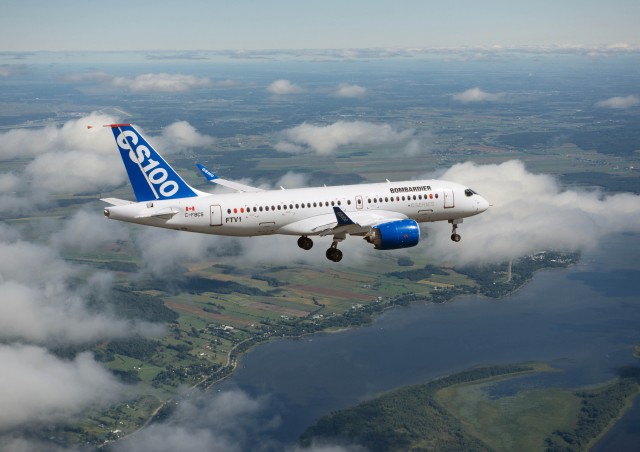
The CS100 during test flights – Photo: Bombardier
Bombardier’s in a bad way lately. Their stock has hit some heavy chop, recently dropping 32% in a three-day period. There’s a margin warning. The company is pricing in a “bankruptcy scenario”. On top of that, the stock fell 11% after they announced the removal of their troubled CEO.
The company is ridiculously leveraged. The cost of a credit default swap on Bombardier has risen 500 basis points. There are even serious questions regarding the company’s liquidity.
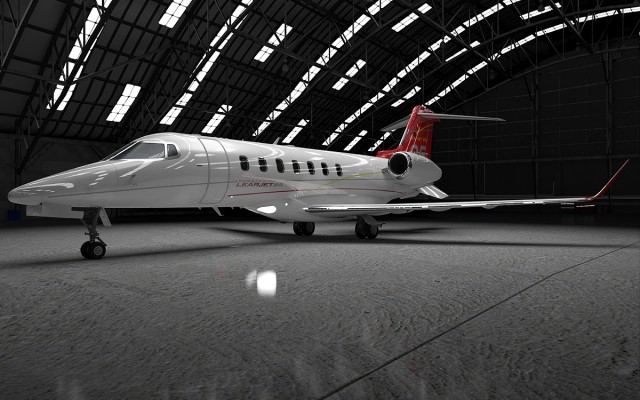
The Learjet 85 – Photo: Bombardier
This whole mess started when the company announced that it was “pausing” its advanced, composite, Learjet 85 for an indefinite period of time due to lack of demand. Now, canceling a business jet should not result in massive investor panic and questions over the viability of a commercial program. The problem is, Bombardier finances a lot of its projects off of the revenue generated by its business jet division and debt. The CRJ and Q400 program, along with trains, are relatively low margin.
There’s a reason investors are starting to, in the words of one firm “[give] up hope.”
Bombardier is suspending its shareholder dividends and working on raising an additional $2.1 billion in capital.
The thing is, in the paraphrased words of Richard Aboulafia at the Teal Group, these moves display a startling amount of intelligence and transparency. The question is, is it too late for Bombardier?
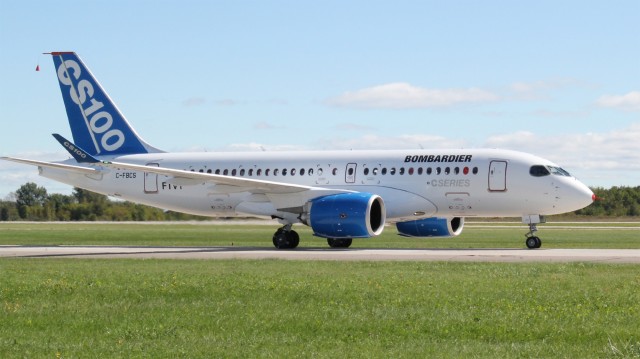
FTV1 stops to take a bow in front of the cheering crowds at YMX after its successful first flight – Photo: Howard Slutsken
The crown jewel of the Bombardier Aerospace lineup going forward was, obviously, the CSeries. Even then, Flightglobal calls it a “mistake Bombardier could not afford to make.”
Plagued by ever-increasing cost-overruns (currently, $1.9 billion dollars above the original projection) and shadowy delays, the program also suffers from a lack of orders. Prior to its entry-into-service (EIS) at the end of this year, Bombardier had hoped to secure 300 orders. The current order book sits at 243, with many of them conditional.
Bombardier itself cites the less-than-stellar sales as a result of airlines being hesitant to order until the flight test data confirms the marketing hype. They also cite that Boeing and Airbus have been aggressively pricing larger frames, which airlines can abuse to fill the CSeries niche.
There’s an elephant in the room, though. It has become pretty standard, at least when purchasing frames from another OEM, for that OEM to offer what could best be described as a trade-in credit. If you order new aircraft, we’ll buy back the aircraft you want to replace and use that to offset the actual purchase cost. Bombardier, despite making the wildly-inefficient 50-seat CRJ-200 series that everyone in the CSeries market is retiring, refuses. Probably because the resale value of 50-seat regional jets is in the tank.
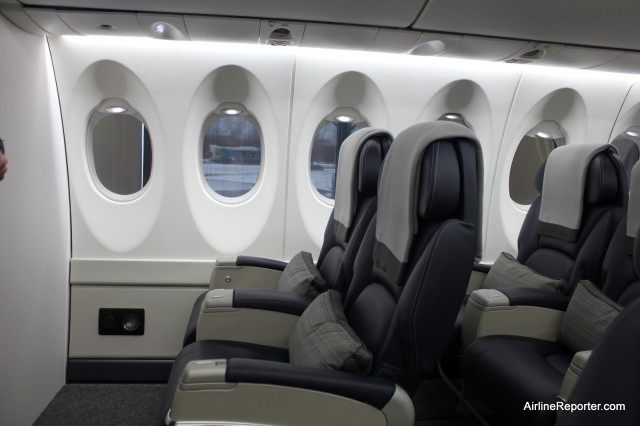
The windows are quite larger on the new CSeries, providing more natural light and shoulder room – Photo: David Parker Brown
It is still utterly unclear why Bombardier, desperate for orders, is unwilling to explore different sales strategies to attract more customers.
Yes, the CSeries has some interesting economics. It can provide the unit cost of a 737-800, but at a drastically lower trip cost. It has the opportunity to fill a gap in many networks as older regional jets become less economical to operate and the competition in the form of Boeing and Airbus begin to focus on aircraft with much higher passenger capacity.
It even helps to disprove the early aviation cultural idiom that small narrowbodies stand to gain no benefit from composite construction. At 46% composite, the CSeries is proof that advanced materials can scale down.
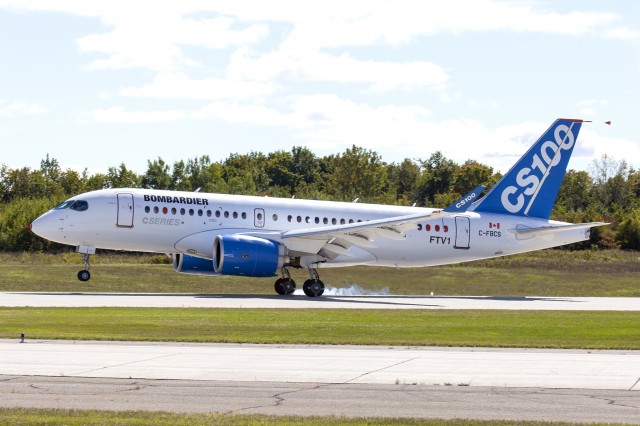
Bombardier CSeries FTV1 touches down on Rwy 06 at YMX after a successful first flight – Photo: Bombardier Aero
By all accounts the CSeries, especially with the Pratt & Whitney PurePower engines – is a fantastic aircraft.
Bombardier, however, has been nothing but cagey with the most important number of all from flight testing – fuel-burn. They have, recently, been hinting that it is beating calculations, but without concrete data, it is very hard to say.
Overall, Bombardier has actually been absolutely shocking at communicating with investors and customers. When the first series of flight-test delays were announced, everyone had seen them coming from miles away.
We can only hope the new executive team is better at prioritizing customer and investor communication.
The problem Bombardier has now is that they are in a situation where they are not even going to come close to pleasing every stakeholder in the CSeries program. They have to issue more stock to raise capital. This will dilute current shareholder value and lower the stock price. The lack of capital and liquidity leaves the company with precious little wiggle room for any further cost overruns the CSeries may face in development. You can have the best product in the world, but if you can’t complete it and get it to market, that will not do them any good.
The last problem is one of confidence.
Investors have none. Investors won’t invest capital in a place where they know they can’t get a return, or might even lose their principle.
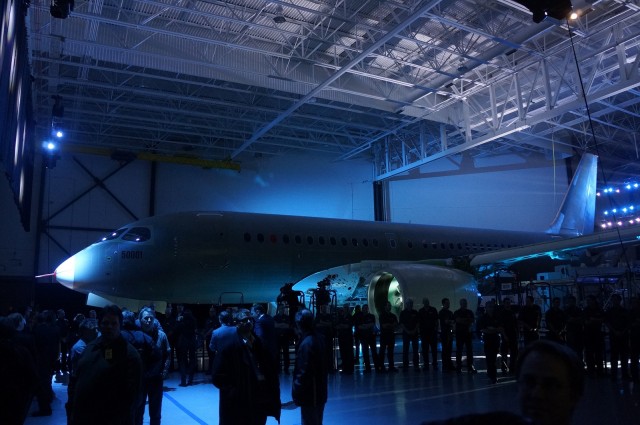
During the CSeries’ unveiling ceremony in Montreal – Photo: Chris Sloan | AirwaysNews.com
Airlines face a different confidence problem. Bombardier says that the aircraft will EIS with its undisclosed launch customer at the end of this year. Even though all signs currently point to that being true, there is another more worrisome problem. No one wants to be stuck with a fleet of uncommon aircraft. Furthermore, a company in a precarious financial situation that may end up teetering on the brink of insolvency is not exactly confidence-inspiring in terms of future ability to obtain spare parts.
Despite all this, I believe that the CSeries is a fantastic aircraft and that it will, one day, be successful. It fills a niche that it will hopefully prove itself in with early data obtained after EIS.
It just wont be a profitable adventure for any current Bombardier investor.
Either that or I am utterly wrong and it will become another Fairchild-Dornier 728.
Comments are closed here.
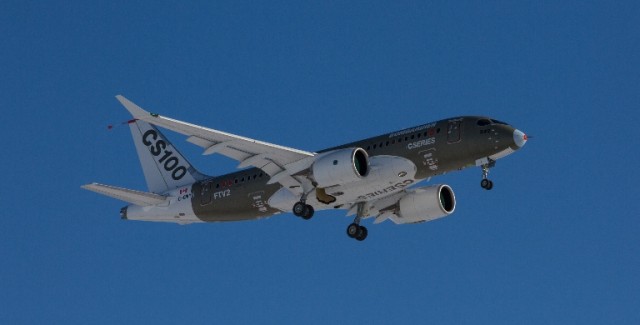
I really liked the article. Let’s keep a few things in mind.
#1. The Cseries had an engine failure that killed it’s schedule. I think it was out about 8 months for the fix. Other than that, I don’t think there’s any other large issues found with the testing so far.
#2 Boeing and Airbus have HUGE backlogs with their small aircraft.
737 ~ 3700 backlog, A320 ~ 4000 backlog.
With these HUGE backlogs, there should be demand in an aircraft a bit smaller than these.
I really hope this aircraft succeeds and surpasses expectations.
Will there be a “white knight” to help the company with capital???. Maybe many airlines have a wait and see position due to the delay’s.??? How does the EMB series compare to the BBD jets???
Stop hiring Presidents and senior management based on their language preference and this company might actually make it out of this alive.
Cseries needs to start deliveries at end of year period. Even if they have to drive on a flatbed truck to its first customer.
Of course it can survive why would it not survive In less than a year before it starts cashing in 62 million dollars per plane? Times some 250 odd planes on the guaranteed order list? That’s 15 billion$ right there in revenue. If you count the options, that’s 500+ planes. Suppose a very low conversion rate of options into orders. that would be ~250 firm orders + 200 planes (300 conditional orders minus conversion rate of 80% = 250 orders). 450 planes. Times 62 million dollars.
Any aircraft built from scratch will encounter a variety of issues (787 , especially today with the fly-by-wire cockpits. The problem is that Bombardier doesn’t have the massive resources that Boeing and Airbus have (Bombardier has struggled to sell planes, current backlog 98 for CRJ jets and 42 for Q jets). While bombardier may be hurting now, if they can pull off the C-series they should be set for the future.
I’ll take 1, placing my Order now !
What will a $1.00 down get me ??
low low interest and the long, long term payment plan ???
Yo’ Job is your Credit , I hope, otherwise I’m out ~ !